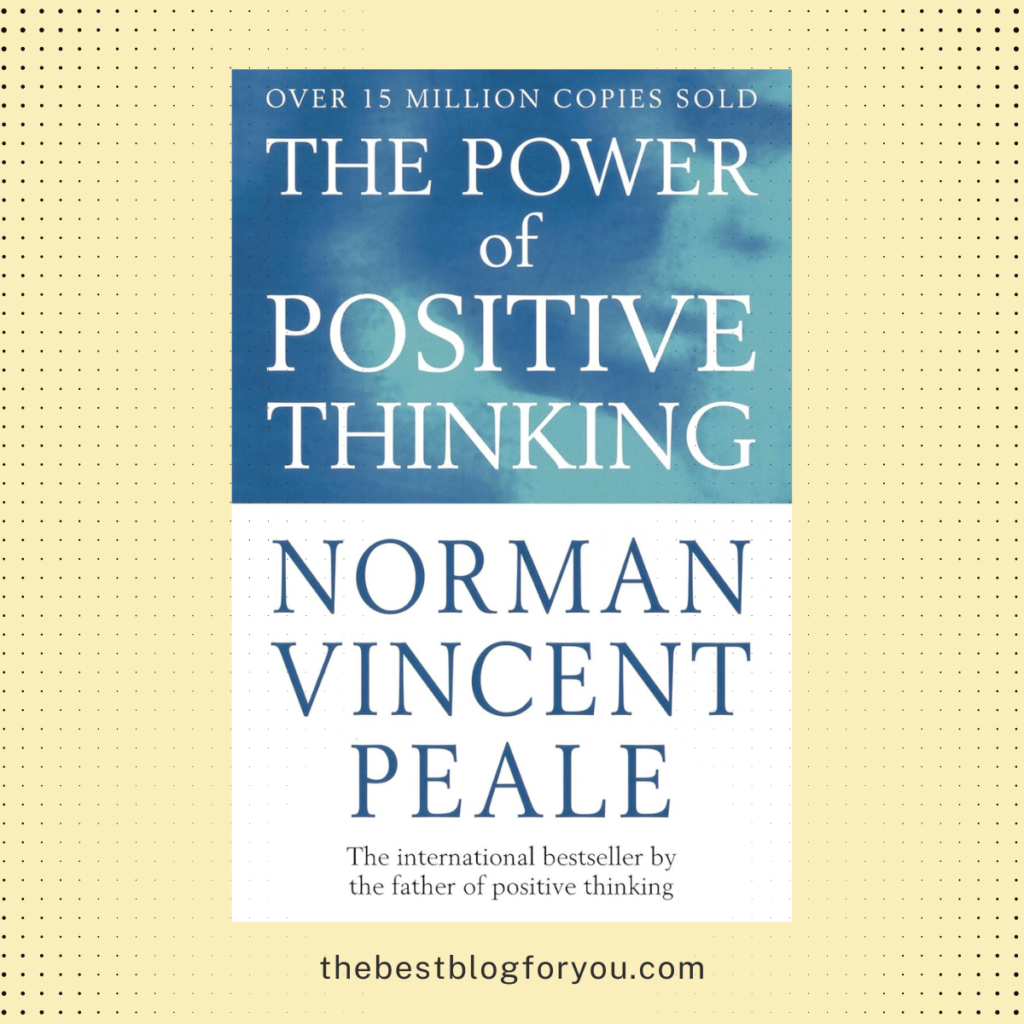
Intro
Norman Vincent Peale’s seminal work, The Power of Positive Thinking, has inspired millions to rethink their outlook on life. The central message of this transformative book is that adopting a positive mindset can lead to significant changes in one’s personal and professional life. This blog post outlines the key takeaways from The Power of Positive Thinking, emphasizing how a shift in perspective can unlock one’s potential and enhance overall well-being.
The Principle of Believing in Yourself

Believing in oneself is foundational to unlocking your true potential. Peale emphasizes that confidence in your own abilities is the first step toward achieving your aspirations. When you genuinely believe in yourself, you are more likely to take bold steps and venture outside your comfort zone. Peale shares numerous instances where individuals succeeded against the odds simply because they maintained unwavering self-belief. This confidence serves as a driving force, propelling you forward even in the face of difficulties. By nurturing a strong sense of self-belief, you empower yourself to embrace opportunities and tackle challenges head-on, making the seemingly impossible attainable.
Cultivating a Positive Mindset Through Affirmations

Affirmations are a critical strategy highlighted by Peale for fostering a positive mindset. This technique involves consistently repeating positive statements to oneself, which can reshape our internal dialogue and boost our self-esteem. By declaring affirmations such as “I am capable and strong” or “I am deserving of success,” you reinforce a mindset that is aligned with your goals and values. This practice can set a positive tone for your day, making you more resilient and focused on achieving your objectives. Peale emphasizes that the power of affirmations lies in their regular use; the more frequently you repeat them, the more they can influence your subconscious mind. This creates a foundation of positivity that can help you navigate life’s challenges with greater ease and confidence.
The Role of Visualization in Achieving Success

Visualization stands as one of the most compelling techniques highlighted in Peale’s teachings. This process involves vividly picturing your goals and the steps needed to achieve them, creating a mental image of success. By doing so, you effectively map out your path, allowing you to focus your efforts more strategically. Visualization taps into the power of the mind-body connection, where imagining a successful outcome can inspire real-world actions that bring you closer to your goals.
Athletes often use this method to enhance their performance, and Peale suggests that the same principle applies to any area of life. When you visualize your achievements, you foster a sense of confidence and clarity, making the abstract more tangible. This practice can also serve as a motivational tool, helping to maintain your enthusiasm and drive even when progress seems slow. Regularly engaging in visualization can reinforce your commitment to your objectives, enabling you to stay focused and resilient.
Moreover, visualization helps in identifying potential obstacles and planning how to overcome them. By mentally rehearsing scenarios, you can prepare yourself for challenges and develop effective strategies to address them. This proactive approach not only boosts your confidence but also equips you with the tools needed to navigate your journey successfully.
Managing Stress Through Positive Thinking

In challenging moments, redirecting your focus to positive outcomes can be a powerful tool for alleviating stress. Peale advises that by reframing stressful situations as opportunities for growth, you can diminish feelings of anxiety and pressure. This mindset shift helps you maintain a clear and calm demeanor, even when under duress. Positive thinking empowers you to take control of your emotional responses, allowing you to tackle problems with a more constructive approach. By cultivating a habit of finding silver linings and potential benefits in difficult scenarios, you train your mind to stay resilient and resourceful. This proactive attitude not only reduces stress but also enhances your problem-solving skills and emotional well-being.
Building Strong Relationships with a Positive Attitude

Approaching relationships with a positive attitude can significantly enhance your interactions and strengthen bonds with others. Peale emphasizes that positivity in communication fosters a supportive and encouraging environment. When you engage with others through optimism and kindness, it not only elevates their mood but also establishes a foundation of mutual respect and trust. Positive attitudes are contagious, and by maintaining a cheerful disposition, you can inspire those around you to adopt a similar outlook. This can lead to more productive and harmonious interactions, whether in personal relationships or professional settings.
A positive mindset helps you listen more attentively and respond more thoughtfully, which are crucial elements in building strong connections. People are more likely to be open and cooperative when they feel understood and appreciated. Peale also suggests that positive thinking enables you to handle conflicts more effectively. By focusing on solutions rather than dwelling on problems, you can navigate disagreements with grace and find common ground more easily.
Additionally, a positive attitude can enhance your ability to provide and receive constructive feedback. When you approach feedback with a mindset geared towards growth and improvement, it becomes a tool for strengthening relationships rather than a source of tension. This open and positive exchange of ideas contributes to a more collaborative and cohesive environment. In essence, positivity acts as a glue that binds relationships, making them more resilient and enduring.
Overcoming Challenges with Optimism and Resilience

Overcoming challenges with optimism and resilience is a core principle in The Power of Positive Thinking. Peale asserts that facing adversity with a positive mindset transforms obstacles into opportunities for growth. This outlook allows you to see setbacks as temporary and surmountable rather than insurmountable roadblocks. By focusing on the potential for positive outcomes, you can maintain motivation and stay committed to your goals despite difficulties.
One technique Peale advocates is to reframe challenges as learning experiences. This shift in perspective encourages a proactive approach to problem-solving, where each challenge is viewed as a chance to develop new skills and insights. Rather than feeling defeated, you cultivate a mindset that is open to creative solutions and new strategies.
Another aspect of resilience involves emotional regulation. By practicing positive thinking, you can better manage your emotional responses, maintaining a sense of calm and clarity even in stressful situations. This emotional stability is crucial for making well-informed decisions and effectively navigating obstacles.
Peale also highlights the importance of perseverance. Resilience is not just about bouncing back but also about pushing forward. Consistently applying positive thinking helps you build the mental fortitude needed to persist through challenges, reinforcing your belief in your ability to overcome adversity.
Incorporating these principles into your daily life can create a robust framework for dealing with difficulties. By maintaining an optimistic and resilient attitude, you empower yourself to face challenges head-on, turning potential setbacks into stepping stones toward success.
The Importance of Gratitude in Positive Thinking

Recognizing and appreciating the good in your life can shift your mindset from scarcity to abundance. Practicing gratitude encourages you to focus on what you have rather than what you lack, fostering a sense of contentment. Peale suggests keeping a gratitude journal, where you can regularly jot down things you are thankful for. This simple practice can cultivate a more positive outlook, allowing you to navigate life’s ups and downs with grace.
Engaging in gratitude can also enhance your emotional well-being by promoting a sense of inner peace. When you consistently acknowledge the positive aspects of your life, you create a buffer against negative emotions such as envy or resentment. Gratitude helps you maintain a balanced perspective, reminding you of the positive experiences and achievements that often go unnoticed.
Furthermore, expressing gratitude can improve your relationships. When you show appreciation for others, it strengthens your connections and fosters a sense of mutual respect. This practice not only enhances your own happiness but also spreads positivity to those around you. By making gratitude a daily habit, you can reinforce a positive mindset that permeates all areas of your life.
Developing a Positive Routine for Daily Life

Developing a positive routine involves integrating habits that nourish your mind, body, and spirit. Start your day with a morning ritual that sets a positive tone, such as mindfulness meditation or stretching exercises. These practices can help center your thoughts and energize you for the day ahead. Additionally, reading inspirational literature or listening to motivational podcasts can provide a mental boost and encourage a growth mindset. Peale also emphasizes the power of positive affirmations and visualization as part of your daily routine, reinforcing your goals and self-belief. Scheduling regular breaks throughout your day for relaxation and reflection can prevent burnout and maintain your productivity. By ending your day with a gratitude practice, you can reflect on the positive aspects of your day, fostering a sense of contentment and well-being. Creating a balanced routine that includes these elements can help you stay focused, resilient, and optimistic, enhancing both your personal and professional life.

6 thoughts on “The 8 Key Takeaways from The Power of Positive Thinking”
Comments are closed.